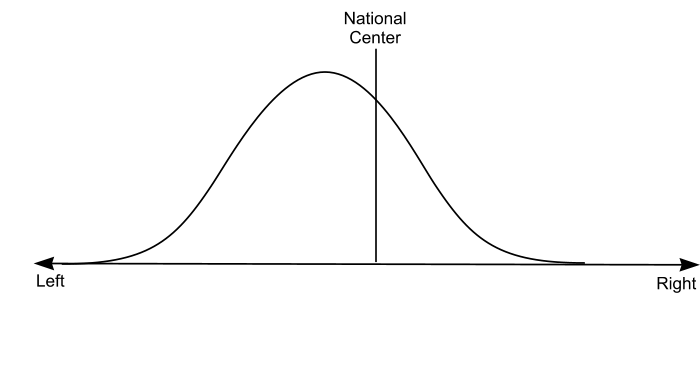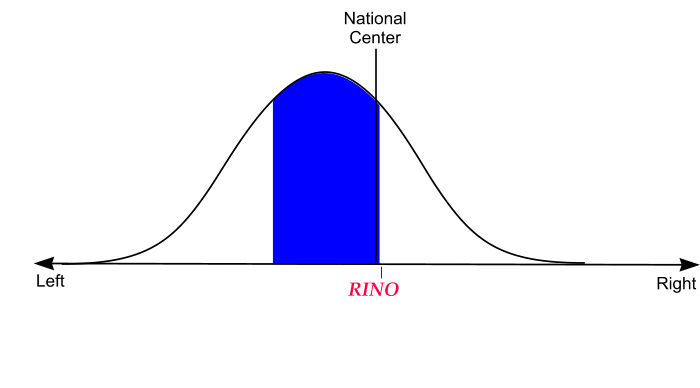Rule 8: Leave No District Unchallenged
After this disappointing Red Ripple, it's time to up our Short Game.
When Left wing parties lack opposition, bad shit happens -- literally in the case of San Francisco. Watch your step! Even some longtime liberals are grossed out. Read some Michael Shellenberger, for example.
Alas, the obvious solution is nearly as gross. It conjures up images of Massachusetts metrosexuals and massive globs of hair gel. Once again, watch your step!
Fortunately, in this Rule I'll give you some not-so-obvious solutions which are considerably less bad, or even outright good. To get there I'm going to need to break out some graphs and teach you the basics of 4D political chess. So get yourself a cup of your focus boosting beverage of choice, be it coffee, cocoa, or chaga mushrooms. It's nerd-out time.
Politics in One Dimension
Believe it or not, most people vote based on issues -- even uninformed people. (The uninformed figure out which party supports their issues and then stop paying attention.) In other words, you are not going to challenge a deep Blue district with Power Words, exposing hypocrisy, or digging up dirt on the incumbent. When candidates are close together on these issues, these tactics are useful. And for executive positions, issues of competence, experience, and self-control can trump ideology. But for a legislative seat from a deep Blue district, you aren't going to elect a Tea Party conservative by exposing hypocrisy or scandals. (And the same holds for electing a rainbow flag waving socialist in a deep Red district.) Environmentalists supported Al Gore despite his enormous personal carbon footprint. The Religious Right supported Trump despite Trump being a foul mouthed playboy who was in the casino business.
Yes, you can sway some close races by getting important facts past the censors. Rule 2 is important. But here I want to put safe seats in jeopardy, and I want to do it soon, long before any education campaign can bear significant fruit. And this demands compromise.
Since the US has mostly plurality-take-all district based elections, races generally boil down to two viable candidates, two viable political parties. As such, it is customary to project issues positions onto a one dimensional axis: the Left-Right political spectrum. Let's start there, even though the model is fatally simplistic, as I'll soon demonstrate.
To make the problem simple, let's ignore looks, personality, name-recognition, etc. and consider a race which is based entirely on issues. Furthermore, we shall focus on a solidly Blue district.
The solid vertical line represents the national consensus. It would be the status quo if our democratic system was efficient and unbiased. This district is a Blue district, so the local center is to the Left of the national center. But the local center is merely liberal, not looney Leftist. Today, such districts are often represented by looney Leftists, and I am breaking out the diagrams to show you why.
Let's see what happens when Team R runs a reasonable conservative:
Assuming that our voter distribution is symmetric, the Democrat can position anywhere within the blue area and be closer to the local center than the Republican. The Democrat can be anything from moderate to Modern Monetary Theorist and still win. The only chance a conservative Republican has of winning this race would be if the Left vote got split by a third party candidate. About the only way to have conservative victories in Blue districts would be to throw massive amounts of money at the Green Party(!) But this is not only expensive; it is a low probability play. The safer bet is to break out the hair gel and run a RINO. [Bleah!]
But it's not an entirely safe bet! If the RINO wins, he might get uppity, and run for President. Or, he might move to a safer district and ruin a safe seat. (Mitt Romney has done both. Send him back to Massachusetts!) For these reasons alone, I suggest you consider running moderate independent candidates or using a third party for challenging deep Blue seats. (But even there, there is still the danger of Presidential aspirations, alas.)
Here are three important reasons for running a RINO (or other moderate):
The RINO might win, causing the district to be represented by someone to the Right of the local median voter, even if that representation is to the Left of the nation as a whole.
The threat of a RINO forces the Democrats to run a liberal instead of an insane Leftist.
If the race is competitive, there will be active poll watchers. This makes it much more difficult for Team D to use the district for ballot stuffing to cheat at the statewide or national level.
To illustrate the second point, have a look at the figure below:
With a RINO in the race, a sane liberal still wins, but a Bernie or Occasional Cortex loses. The Democrat can move no further to the Left from the local center than the RINO is to the Right.
Conversely, if Team R was to run a full on Tea Party conservative, the Democrats would have a license to run anyone to the Right of Pol Pot. (And this, by the way, is why the liberal media actively promoted Donald Trump during the 2016 Republican primaries. They thought he was an easily beaten extremist. What they didn't realize is that Trump was playing 4D chess; Trump was actually closer to the American center than recent RINOs. Details coming in Part 2.)
Now here is why Team D has gone insane: political parties are run by radicals and remoras. There is tremendous pressure to appease fringe ideologues and/or special interests. In a Lefty district, if the Democrat can go Left in the general, she will have to. To stay moderately liberal is to face a primary challenge or a Green Party challenge in the general. Meanwhile, corporate special interests have gone woke for several reasons:
Being Woke provides some protection from lawsuits.
Wokeness is a great distraction from the wealth gap. Corporations went woke after Occupy Wall St. gave them a scare.
Wokeness is a good cover for importing cheap labor and outsourcing jobs to China.
Between the far Left activists and the Woke multinational corporations, Team D is pressured to run the kind of poisonous anti-American Internazis you see today. In other words, sane patriotic liberals need RINOs in order to politically survive.
Refining the One-D Model
So far, the model has been very crude, assuming rational informed issue-oriented voters with no concern about competence, morals, or name recognition. As we relax this model we need to tighten things up a bit, starting with the hair. It's time to explain the hair gel factor.
Some voters put stock in surface signals of stability and competence. With his perfect clothes, hair, and Harvard MBA, Mitt Romney gave off vibes of normalcy, executive experience, and competence. Contrast Mitt's appearance with the chaos, bad manners, and bad hair days of Donald Trump. Or contrast Mitt with the blue hair, tie-dye, and tattoos found on the far Left. A government run by Romney seems like a safe bet -- as long as you don't look at the fate of the companies he looted..
So yes, charm and appearance are worth a few points, especially when the other side runs one of its chaotic ideologues.
Another factor we need to incorporate into our model is uninformed voters. You get no "credit" for being a RINO if the voters don't know you personally. If low information voters look only at the Republican brand, and that brand is not locally popular, then Team D gets the low information voters. A RINO thus needs lots of money and/or prior name recognition. Think Arnold Schwarzenegger for an example of the latter.
Once upon a time, when the Left threatened to loot Corporate America, Republicans could count on mass quantities of remora money to support their RINOs. Today, with Team D going Internazi, and Team R going populist and protectionist, more of the remora money is going to Team D.
This brings me to another reason to have a moderate third party to run moderates in Blue districts vs. relying on RINOs. An ideologically moderate third party can build a reassuring brand, which can be reused for many candidates. A RINO doesn't have to merely brand himself; he has to do a rebrand against the Orgulous Orange Man. Rebranding can be hideously expensive.
But can a moderate party work? Moderate parties have a history of rapidly disintegrating after their founders finish using them for ballot access. Long lasting third parties tend to be principled and extreme. To see why moderate parties disintegrate rapidly, we need to do a deep dive on the definition of "moderate" in a political context.
The Meaning of "Moderate"
There is a fundamental problem with the term Moderate: it is ambiguous. I can create two Moderate political platforms which have nothing in common(!) To demonstrate, I'll list a set of strong liberal and conservative positions from a more civil time, before America entered the Crazy Years.
Liberal: Pro abortion, Pro gun control, Pro welfare, Tax increases for the Rich, Legalize Recreational Drugs.
Conservative: Anti abortion, Pro gun, Anti welfare, Tax cuts for the Rich, Fight the Drug War.
I can shuffle these positions and create two completely disjoint Moderate political platforms.
Moderate 1: Pro abortion, Pro gun, Anti welfare, Tax cuts for the Rich, Legalize recreational drugs.
Moderate 2: Anti abortion, Pro gun control, Pro welfare, Tax increases for the Rich, Fight the Drug War.
Both platforms average out as centrist on the Left-Right political spectrum, yet they have no positions in common. The first Moderate platform is pretty much a chunk of the Libertarian platform, and thousands of experiments have been run using the platform. Surprise! It works nowhere close to as well as the the simplistic left-right model above would indicate. A really active Libertarian campaign can once in a blue moon manage to get 25% of the vote in a two-way race against a Democrat. Maybe the Libertarian Party needs to invest in hair gel.
Or maybe the model is defective. Maybe you cannot accurately map political positions onto a one dimensional political spectrum using linear algebra.
For the Libertarian Party, the obvious defect is that the LP takes a mix of extreme liberal and conservative positions. For some strange reason these do not average out to Moderate in the minds of ordinary voters.
A moderately libertarian party might be able to win races in Blue districts where even RINOs struggle. The converse is definitely true: a moderate authoritarian is pretty much the mainstream media's definition of Moderate. I think I prefer Alexandria Ocasio-Cortez to such Moderates. More fun to watch; less insidious.
Perhaps the purest way to be a Moderate is to take a moderate stand on every issue. In a sense, this is the most conservative position of all: don't change anything. While such candidates would be an improvement over AOC, I expect limited enthusiasm for launching a party on this platform -- or a caucus within the Republican Party for that matter. In a happier time this might work, but America is not a happy place right now.
Moderation is not enough.
[Here ends Part 1 of Rule 8. In Part 2, we will look at a four dimensional political model and search for market niches, for something better than running RINOs.]








I'm looking forward to Part 2. This is intriguing.